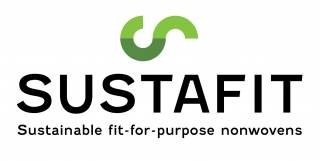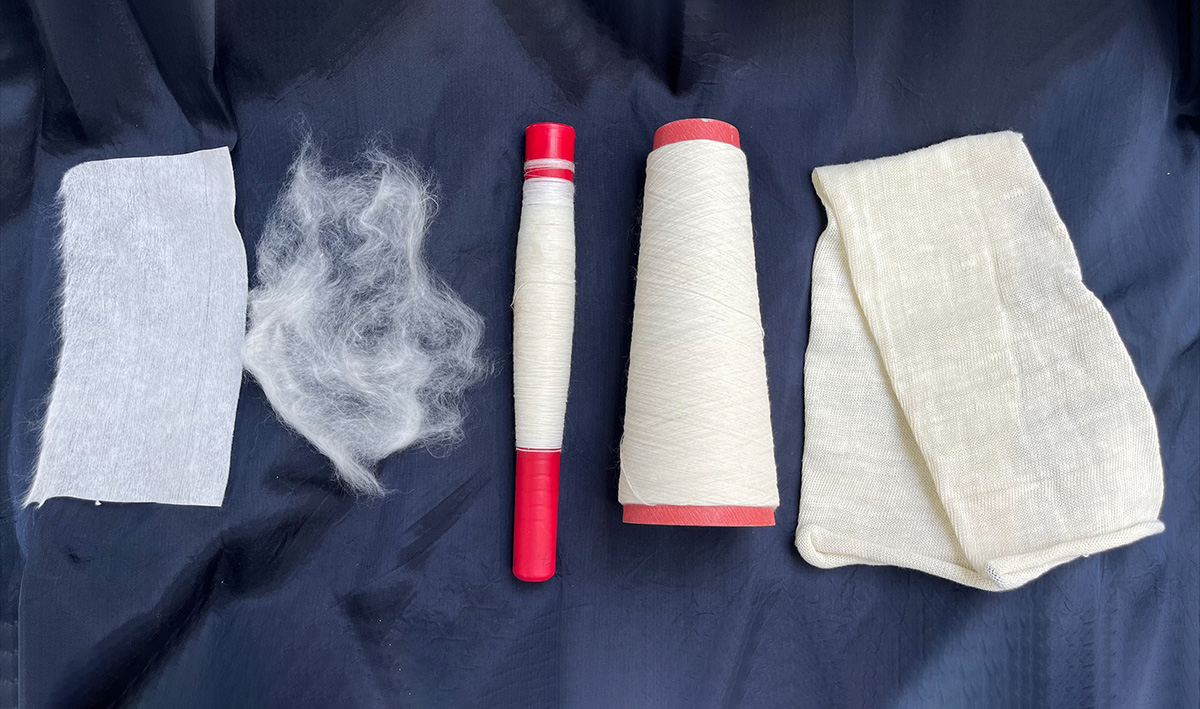One of these sources studied by Emily Hart was recycled nonwovens, which showed great promise for the production of nonwovens in the future. Currently, the industry relies heavily on non-renewable raw materials such as polyester and polypropylene and is in need of new raw material feedstocks. The thesis was a part of her studies in the master’s programme in Chemical, Biochemical and Materials Engineering at Aalto University and a part of the Sustainable Fit-For-Purpose Nonwovens (SUSTAFIT) project.
How do we do that?
The Ioncell technology allows for the use of varying cellulose sources, such as cardboard, newspaper, cotton, hemp, and bacterial cellulose. (Haslinger et al., 2019; Ma, Hummel, Kontro, & Sixta, 2018; Ma et al., 2016; Rissanen et al., 2023; Silva et al., 2024)
In this work we wanted to recycle a 100% Lyocell nonwoven fabric. The recycled nonwovens required chemical pre-treatment to remove additives before dissolving the cellulose in an ionic liquid. Ionic liquids are salts with a melting point below 100˚C which can be used as solvents for man-made cellulosic fibres. (Wang, Gurau, & Rogers, 2012) Additives are commonly used in nonwovens to bind the fibres together, give the fabric properties such as water repellence or antimicrobial properties or to change the appearance. NaOH was used to remove possible binders and H2SO4 for removing a mattifying agent. The initial spinnability was first tested with a monofilament spinning unit. The spinnability was very poor without any pre-treatment. The best working pre-treatments were then upscaled to a multifilament system.

The best spinning results were achieved when the mattifying agent was removed with H2SO4. However, for certain applications this might not be necessary. If the produced fibres are meant for nonwoven production, the mattifying agent would most likely be added again and sufficient spinnability could be reached without removing it. If the produced fibres were meant to be used for applications where thinner fibres were needed, for example garments, the mattifying agent should be removed.
The tenacity of the produced fibres was slightly lower compared to standard Ioncell® fibres, but comparable with other fibres produced from recycled materials. The fibres treated with both NaOH and H2SO4 had a slightly lower tenacity than the fibres treated with NaOH only. The slightly lower tenacity of the recycled fibres is caused by the impurities in the nonwovens compared to pure wood pulp. Ioncell fibres in general have a very high tenacity (up to 50 cN/tex) compared to other commercial man-made cellulosic fibres. (Ma et al., 2016) The elongation of the recycled fibres was also slightly lower than that of standard Ioncell fibres.
The produced fibres were further processed both into new nonwoven fabrics as well as upcycled into yarn and a jersey fabric by VTT and Aalto University, respectively.

Why is this important?
The typically short lifespan of nonwoven products creates disposability problems, which is an issue for the increasing environmental concern of customers as well as new legislation aiming to protect the environment. The most notable recent legislation affecting the use of nonwovens in Europe is the European Union’s (EU) directive on single-use plastics (SUP) (EU Directive 2019/904, 2019). This directive is aiming to prevent and reduce the effects that single-use plastics have on the environment.
In 2021 more guidelines were released (EU 2021/C 216/01, 2021), in which plastics are defined as chemically modified polymers, thus excluding natural polymers. Therefore, MMCFs are regarded as a good alternative. Regenerated cellulose fibres such as viscose, Lyocell, and Ioncell® are considered natural polymers since there is no chemical modification of the cellulose and are thus not restricted by the SUP directive. Regenerated cellulose is also bio-based and biodegradable, which lowers the impact on the environment in the case that it would end up in nature after use.
Currently the main source of cellulose for MMCFs is wood pulp or cotton linter. (Shen, Worrell, & Patel, 2010). It is important to find alternative cellulose sources to put less pressure on forest ecosystems and widen the availability of sustainably produced cellulose for the growing demand of the textile industry. Recycling in the textile industry is also underdeveloped at the moment and could be a source for raw materials.
Text and additional information:
Nicole Nygren
M.Sc. (Tech)
Doctoral Researcher, Department of Bioproducts and Biosystems
Aalto University
References:
Haslinger, S., Wang, Y., Rissanen, M., Lossa, M. B., Tanttu, M., Ilen, E., . . . Sixta, H. (2019). Recycling of vat and reactive dyed textile waste to new colored man-made cellulose fibers. Green Chemistry, 21(20), 5598-5610.
Ma, Y., Hummel, M., Kontro, I., & Sixta, H. (2018). High performance man-made cellulosic fibres from recycled newsprint. Green Chemistry, 20(1), 160-169.
Ma, Y., Hummel, M., Määttänen, M., Särkilahti, A., Harlin, A., & Sixta, H. (2016). Upcycling of waste paper and cardboard to textiles. Green Chemistry, 18(3), 858-866.
Rissanen, M., Schlapp-Hackl, I., Sawada, D., Raiskio, S., Ojha, K., Smith, E., & Sixta, H. (2023). Chemical recycling of hemp waste textiles via the ionic liquid based dry-jet-wet spinning technology. Textile Research Journal, 93(11-12), 2545-2557.
Shen, L., Worrell, E., & Patel, M. K. (2010). Environmental impact assessment of man-made cellulose fibres. Resources, Conservation and Recycling, 55(2), 260-274.
Silva, F. A., Schlapp-Hackl, I., Nygren, N., Heimala, S., Leinonen, A., Dourado, F., . . . Hummel, M. (2024). Upcycling of cellulosic textile waste with bacterial cellulose via Ioncell® technology. International Journal of Biological Macromolecules, 132194.
Sixta, H., Michud, A., Hauru, L., Asaadi, S., Ma, Y., King, A. W., . . . Hummel, M. (2015). Ioncell-F: a high-strength regenerated cellulose fibre. Nordic Pulp & Paper Research Journal, 30(1), 43-57.
Smithers. The Future of Global Nonwovens Markets to 2024. .(2019). https://www.smithers.com/services/market-reports/nonwovens/the-future-of-global-nonwovens-to-2024 Accessed.
Wang, H., Gurau, G., & Rogers, R. D. (2012). Ionic liquid processing of cellulose. Chemical Society Reviews, 41(4), 1519-1537.



